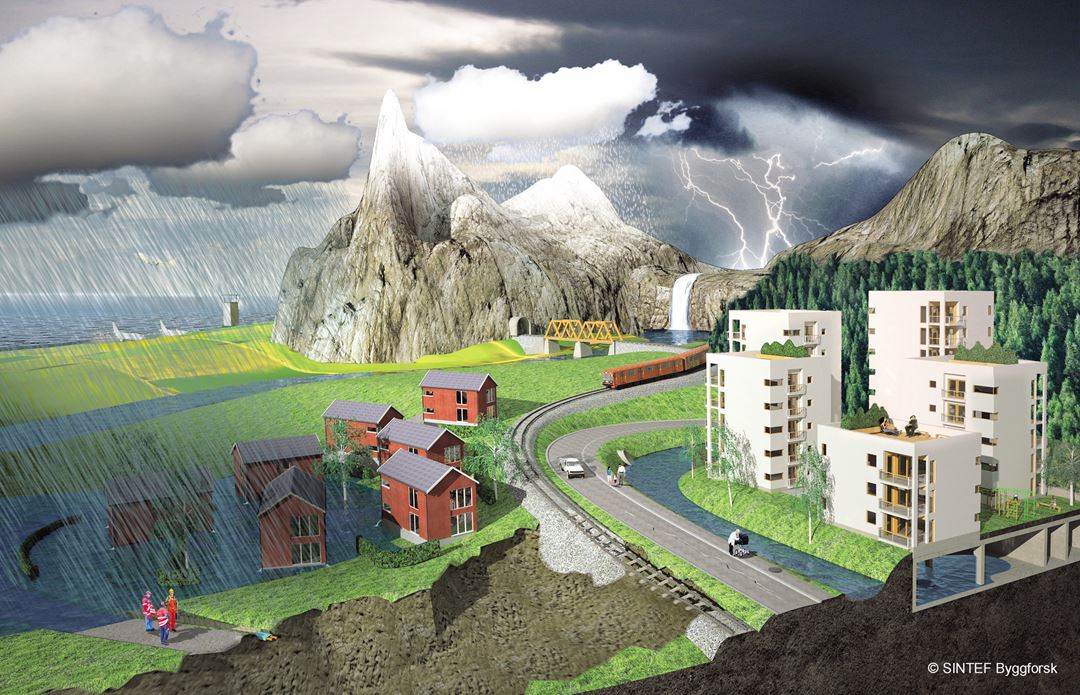The Centre will strengthen companies' innovation capacity through a focus on long-term research. It is also a clear objective to facilitate close cooperation between R&D-performing companies and prominent research groups.
The main objective
The main objective of SFI Klima 2050 is to reduce the societal risks associated with climate changes and enhanced precipitation and flood water exposure within the built environment. Emphasis will be placed on development of moisture-resilient buildings, stormwater management, blue-green solutions, measures for prevention of water-triggered landslides, socio-economic incentives and decision-making processes. Both extreme weather and gradual changes in the climate will be addressed.
Very high standard
Executive vice president Hanne Rønneberg at SINTEF Building and Infrastructure consider the assignment of the SFI status to Klima 2050 as a confirmation that the group is in the elite division of research.
– The Research Council of Norway has emphasised that the quality of the centre applications has been of a very high standard, and we got our application accepted competing with 56 other excellent candidates, says Rønneberg.
The foundation of Klima 2050 has been laid through many years of industrial research on effects of climatic exposure, among other initiatives through the large-scale Klima 2000 programme (2000-2007).
– We have the best researchers, long and solid traditions within climate research, and one of Europe's most modern research laboratories within climatic exposure on buildings. We are looking forward to cooperating with the strongly motivated partners in the consortium, says Rønneberg.
The solutions must be developed now
Extreme weather occurrences during the last years have shown us how vulnerable we are when buildings and infrastructure are put to test. Knowing that the expected lifespan of buildings, roads and railways ranges from 40 to more than 100 years, the solutions must be developed now.
– By solving today's problems, we are better equipped to meet the challenges of the future, says Dean Ingvald Strømmen at NTNU's Faculty of Engineering Science and Technology, pointing out last autumn's flood incidents in the western parts of Norway, as a confirmation of the Centre's relevance.
Enables long-term research
The SFI status enables long-term research in close collaboration with trade and industry, as well as other research partners aiming to strengthen Norway's innovation ability and competitiveness within climate adaptation. The composition of the consortium is vital in order to being able to reduce the societal risks associated with climate change.
– Klima 2050 will be an arena of great value for developing new and robust solutions for climate adaptation of buildings and infrastructure, especially in the light of future risks associated with a changing climate – and the need for geographically dependent design, says Director Kim Robert Lisø at Skanska Norway.
A strong team
The host institution for SFI Klima 2050 is SINTEF, and the centre will be directed in cooperation with NTNU. Chief scientist Berit Time at SINTEF Building and Infrastructure is the centre director, and Professor Tore Kvande at NTNU is the principal investigator.
SINTEF and NTNU cooperate with a strong team in Klima 2050. The research partners are BI Norwegian Business School, Norwegian Meteorological Institute (MET Norway) and Norwegian Geotechnical Institute (NGI). The business partners represent important parts of Norwegian building industry; consultants, entrepreneurs and producers of construction materials: Skanska Norway, Multiconsult AS, Mestergruppen Bolig, Norgeshus AS, Saint-Gobain Byggevarer AS, Isola AS and Spenncon AS. The centre also includes public builders and property developers: Statsbygg, Statens vegvesen, Jernbaneverket og Avinor AS. Important are also The Norwegian Water Resources and Energy Directorate (NVE) and Finance Norway.


